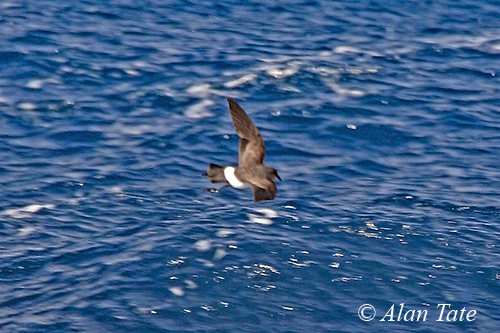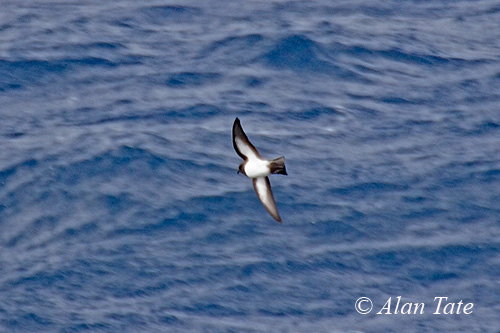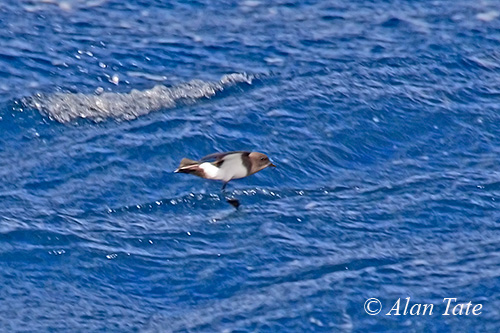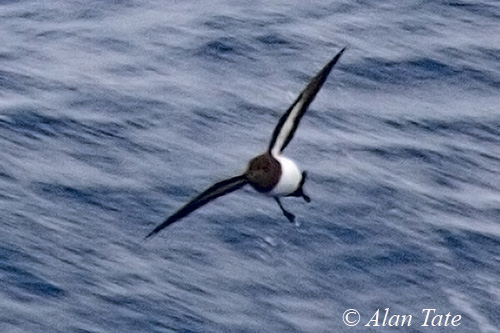
Fr: Océanite à ventre blanc
Ang: White-bellied Storm-Petrel
All: Weißbauch-Sturmschwalbe
Esp: Paíño Ventriblanco
Ita: Uccello delle tempeste panciabianca
Nd: Witbuikstormvogeltje
Sd: vitmagad stormsvala
Photographers:
Alan & Ann Tate
AA Bird Photography
Text by Nicole Bouglouan
Sources:
HANDBOOK OF THE BIRDS OF THE WORLD vol 1 by Josep del Hoyo-Andrew Elliot-Jordi Sargatal - Lynx Edicions - ISBN: 8487334105
OISEAUX DE MER – Guide d’identification de Peter Harrison – Editions Broquet (Canada) – ISBN-10 : 2890004090 – ISBN-13 : 978-2890004092
A dark-morph White-bellied Storm Petrel Fregetta grallaria off Más Afuera (Alejandro Selkirk) Island, Juan Fernández archipelago, Chile?
New Zealand birds and birding (Narena Olliver)
Wikipedia, the free encyclopaedia
White-bellied Storm-Petrel
Fregetta grallaria
Procellariiformes Order – Oceanitidae Family
INTRODUCTION:
The White-bellied Storm-Petrel is a little-studied species, easily confused with similar other species of black-and-white storm-petrels. It has a wide range in the south Pacific, Atlantic and Indian Oceans, ranging into tropical waters from its various breeding grounds. Four subspecies share the range.
The White-bellied Storm-Petrel breeds on offshore remote islands where it forms loose colonies. It typically nests in rock crevices and burrows amongst boulders or on grassy slopes. Outside of the breeding season, the species is marine and highly pelagic.
It feeds mainly on small fish and squid, but it also consumes some crustaceans, marine insects and Halobates.
The White-bellied Storm-Petrel is threatened by predation by invasive species, and light pollution on Tristan da Cunha and Juan Fernández Islands have also a negative impact. But the White-bellied Storm-Petrel is not globally threatened at the moment.
DESCRIPTION OF THE BIRD:
Biometrics:
Length: 18-22 cm
Wingspan: 46-48 cm
Weight: 45-65 g
The White-bellied Storm-Petrel can be confused with other black-and-white storm-petrels such as the Black-bellied Storm-Petrel, the Grey-backed Storm-Petrel and the New Zealand Storm-Petrel, although some morphological features help to separate them.
The White-bellied Storm-Petrel is a small to medium-sized storm-petrel.
The upperparts, including head, throat and upper breast are charcoal-brown. The uppertail-coverts are white and contrast strongly with the square blackish tail. Back, scapulars and mantle feathers show narrow white fringes in fresh plumage. On the upperwing, the greater coverts are paler brown and form a narrow wingbar. The flight feathers are blackish.

The underparts are white on lower breast, belly and underwing-coverts. Undertail and both broad leading and trailing edges are blackish, like the large wing tip.
The entire head is blackish-brown, forming a dark hood.
Bill, legs and webbed feet are black. The eyes are dark brown.
Male and female are similar, but the female is slightly larger.
The juvenile resembles adults.
SUBSPECIES AND RANGE:
The White-bellied Storm-Petrel has four subspecies.
F.g. grallaria (described above) is found in tropical W Pacific Ocean. It breeds on Lord Howe Island and Kermadec Island.
F.g. leucogaster occurs in S Atlantic and S Indian Oceans. It breeds on Tristan da Cunha, Gough Island and St Paul Island.
F.g. segethi is found in SE Pacific Ocean. It breeds on Juan Fernández Islands and Desventuradas Islands.
F.g. titan occurs in S Pacific Ocean. It breeds on Rapa Island in Austral Islands in French Polynesia.
HABITAT:
The White-bellied Storm-Petrel is marine and pelagic. It rarely comes to land, except near the colonies.
It breeds on offshore islands and rocky outcrops in dispersed colonies established amongst boulder scree or on grassy slopes, usually up to 450 metres above the sea-level.

CALLS AND SONGS: SOUNDS BY XENO-CANTO
The White-bellied Storm-Petrel is silent at sea, but when on land at the colonies, it gives soft, high-pitched, twittering calls described as “pee-pee-pee-pee…” often repeated up to 20 times.
It also produces a grating call in alarm when threatened.
BEHAVIOUR IN THE WILD:
The White-bellied Storm-Petrel feeds mainly on fish and squid, but some crustaceans, marine insects and sea-skaters (Halobates) are also consumed.
It forages by skimming low over the sea and pattering the water with its webbed feet, producing extensive kick-splashing against the surface. Then, it quickly changes the direction of the flight, involving movement in Halobates species. It also feeds on the wing by pattering and dipping.
It usually forages far from the shore, both at day and at night, sometimes with other seabirds. It also follows the ships.
The White-bellied Storm-Petrel forms loose colonies. They nest in rock crevices or burrows built in woodland, tussock or fern habitat. It is nocturnal at the colonies, although it may visit the nesting sites during the day, especially on Rapa Island and Inaccessible Island. Both parents share the nesting duties.
The movements of the White-bellied Storm-Petrel are poorly known. The species probably moves after breeding, and the maximum dispersal has been estimated at several thousand kilometres. More information is needed.
The White-bellied Storm-Petrel flies low above the water, gliding and pushing off the water surface with the webbed feet. It seems to hit the surface of the sea with the breast, and then, it uses the legs to rebound.

REPRODUCTION OF THIS SPECIES:
The breeding season takes place in late summer and autumn. The laying period extends usually from January to March, and the young fledge from mid-April to May.
The White-bellied Storm-Petrel nests in loose colonies established on oceanic islands. It nests in rock crevice between volcanic rocks, or excavates a burrow in grassy banks and slopes. Inside the burrow, the nest-chamber is sparsely lined with dried grass.
The female lays a single, dull white egg with fine reddish-brown spots. The incubation is shared by both adults but the duration is unknown. At hatching, the downy chick is dark grey with black bill, legs and feet. It is fed by both parents on a mixture of crustaceans and squid.
PROTECTION / THREATS / STATUS:
The White-bellied Storm-Petrel is affected by habitat loss and predation by invasive species, probably introduced by fishing vessels and land-based activity.
The main predators are the domestic cat and the black rat. They cause reduced reproductive success, mortality and habitat degradation. Light pollution on Tristan da Cunha and Juan Fernández Islands have also a negative impact.
Climate change may affect the seabirds, as they are vulnerable to changes of sea temperatures.
The global population is estimated to number around 300,000 individuals. It is suspected to be declining.
But currently, the White-bellied Storm-Petrel is evaluated as Least Concern.
